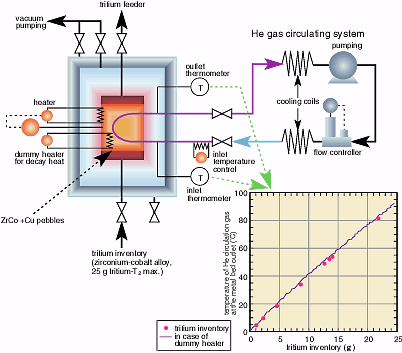 magnified picture |
|||||
|
|||||
| A fusion reactor keeps a total of several kg of tritium as fuel, and burns it slowly. Tritium is an isotope of hydrogen and emits weak beta radiation with a 12 years half life, decaying to helium (3He). Tritium should be isolated to the utmost, because if tritiated water is mixed in organisms, its radiation causes biological effects. Tritium should be confined inside a fusion reactor, and it is most important to always know the total tritium quantity. Tritium gas is absorbed in metal beds in a fusion reactor and heats the metal by its beta radiation. A helium gas cooling system is deployed to keep the metal bed at constant temperature. In this case, it is in principle possible to estimate the quantity of tritium by measuring the quantity of heat transferred to the cooling helium gas. The issue is the measurement of the heat with adequate accuracy. A concept of a tritium monitoring system to measure the heat quantity in a gas flowing system is shown in Fig. 2-15. Experimentally, it is shown that the stochastic error of the tritium quantity is less than 1% for 25 g of tritium which is the maximum absorbed in each metal bed. It is usually believed that a calorimetric measurement is poor in its accuracy due to thermal conduction and radiation loss of the systems. This is a counter example to such common knowledge. |
| Reference T. Hayashi et al., Tritium Inventory Measurement by "In-Bed" Gas Flowing Calorimetry, Fusion Technol., 30 (3), 931 (1996). |
| Select a topic in left column |
|
Persistent Quest-Research Activities 1998 Copyright(c)Japan Atomic Energy Research Institute |